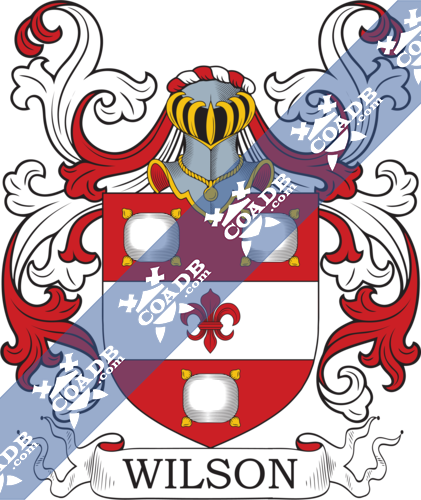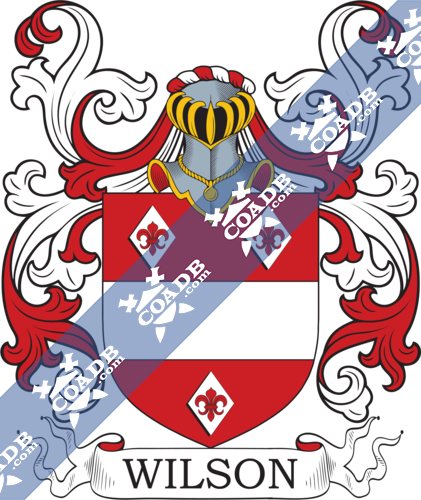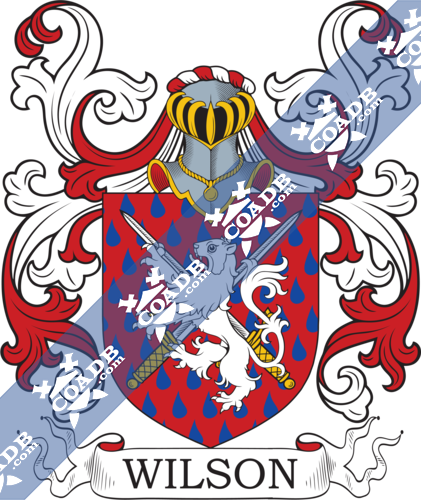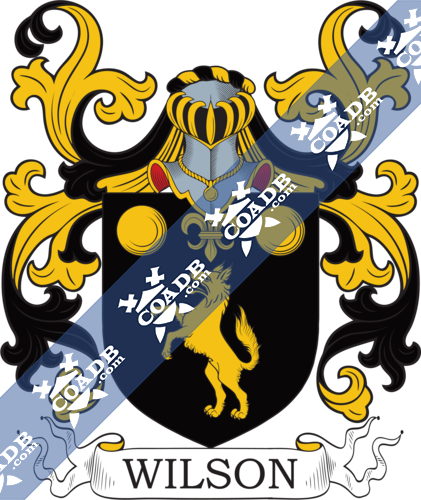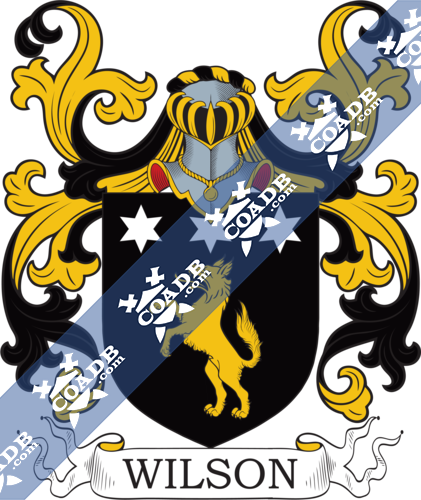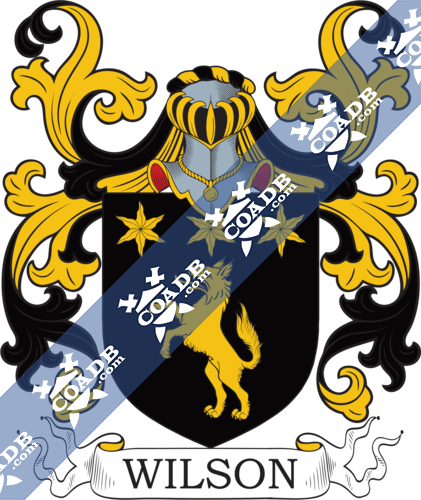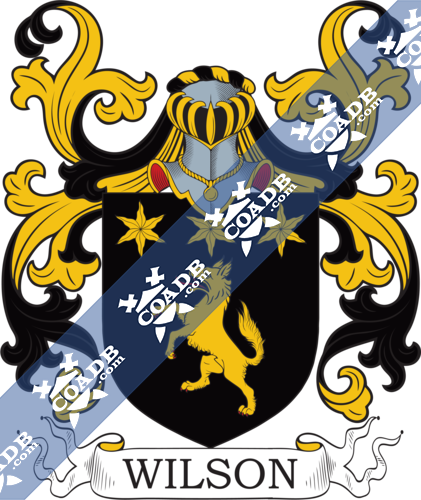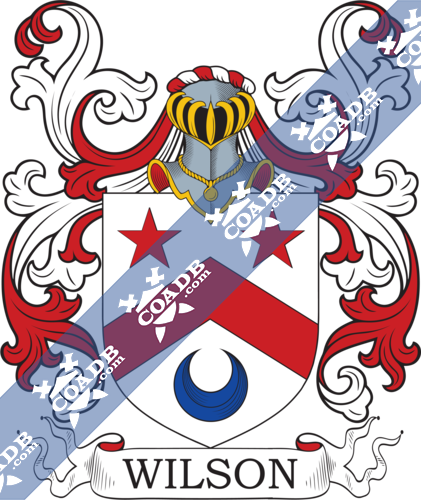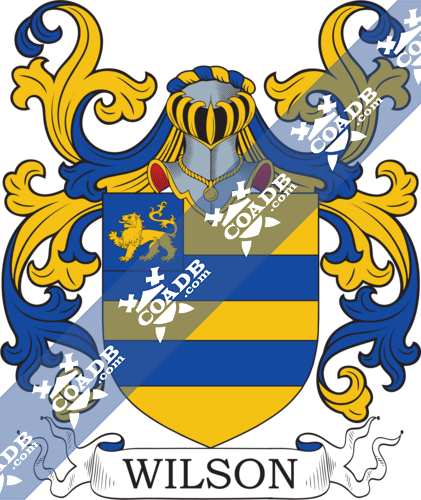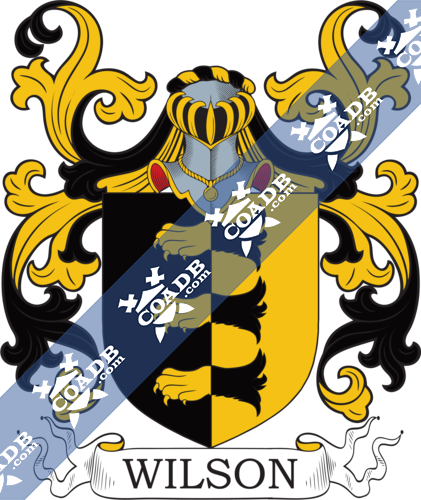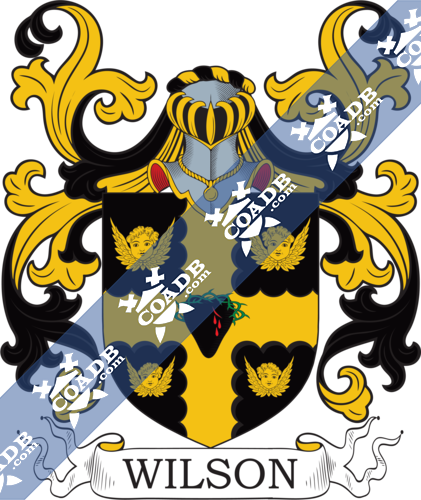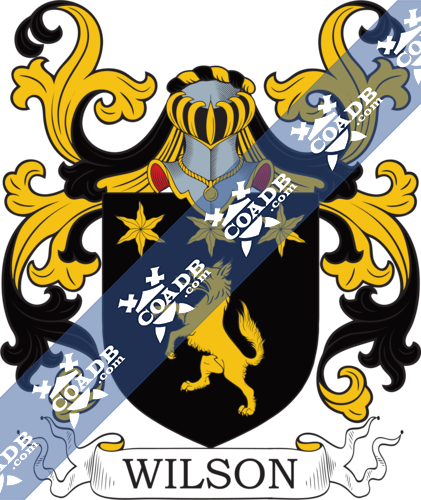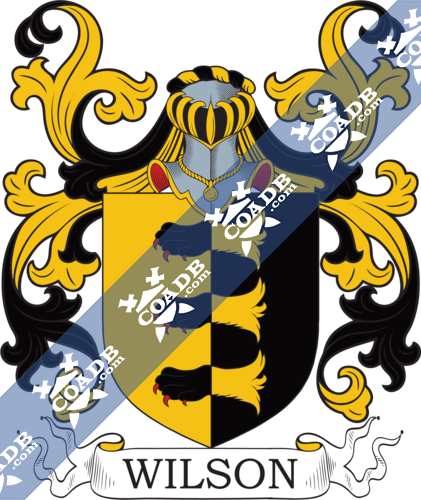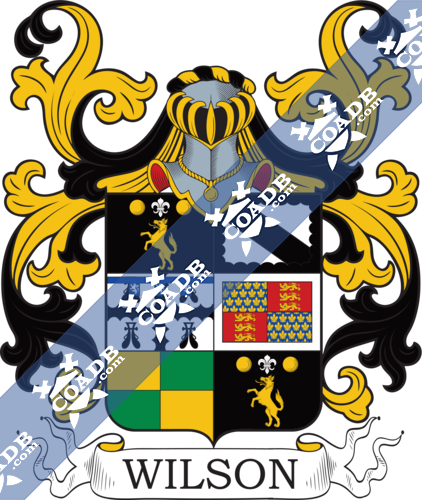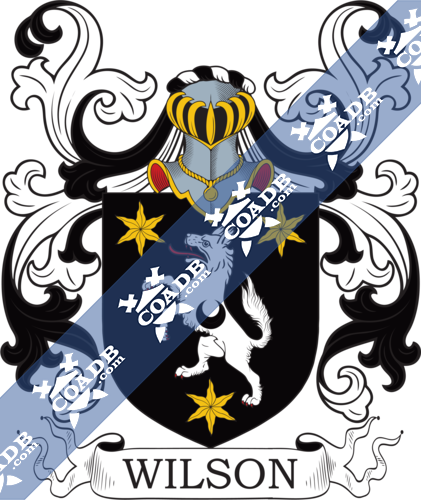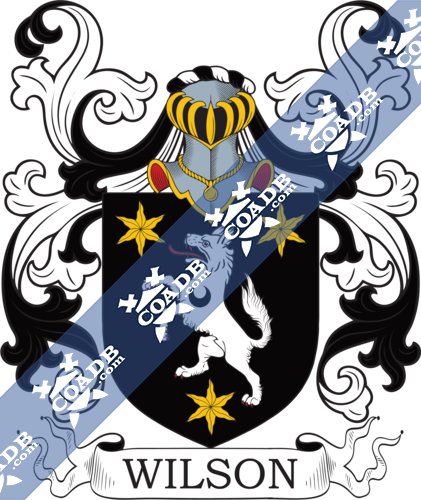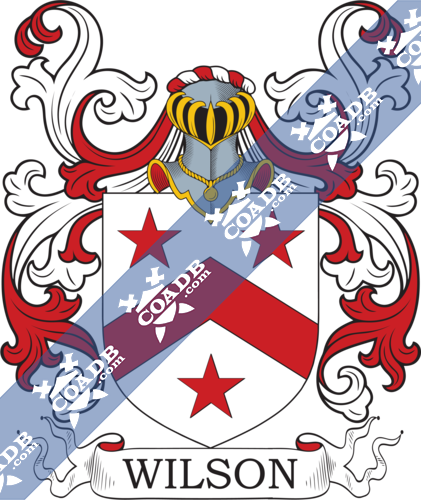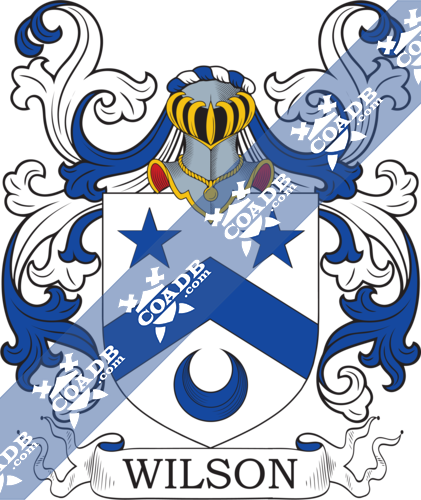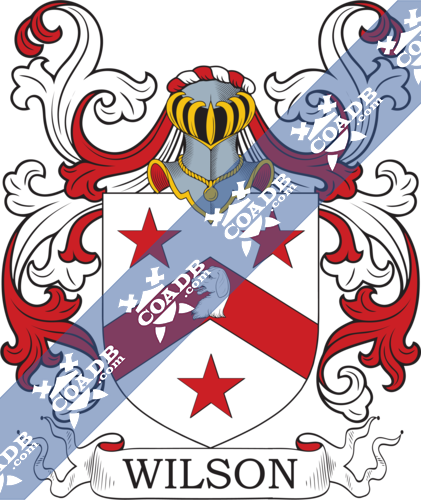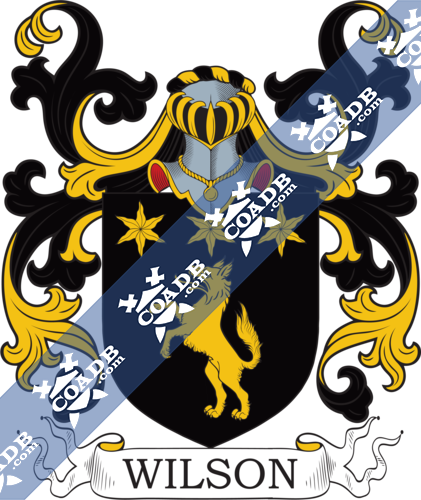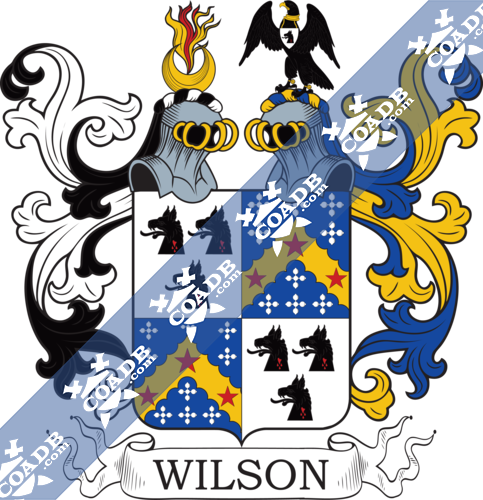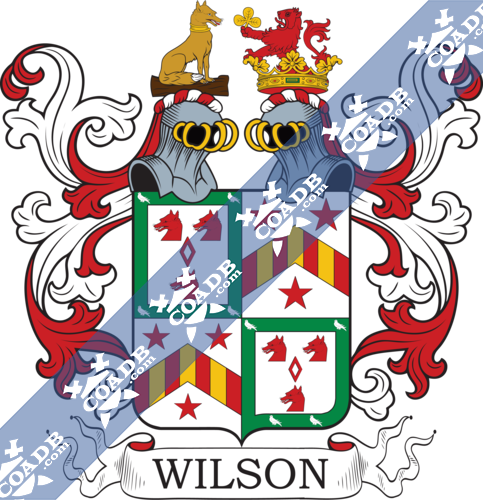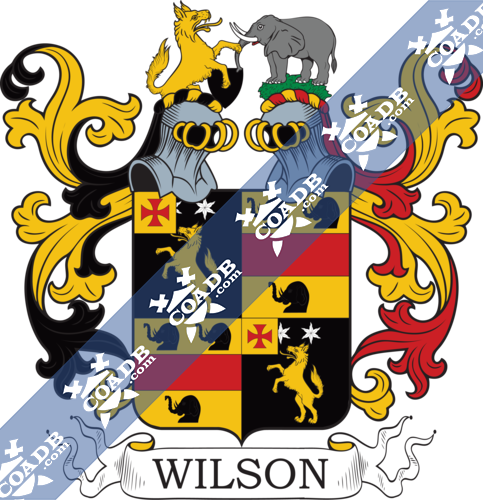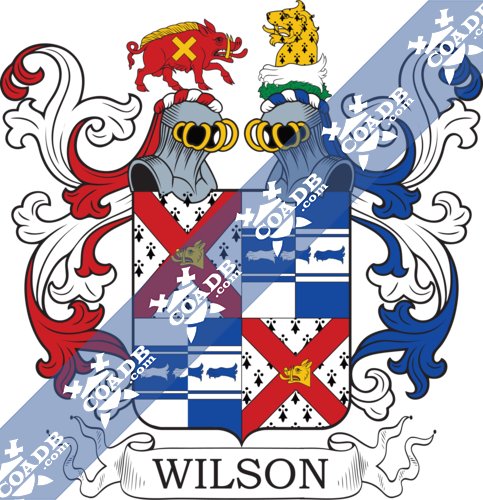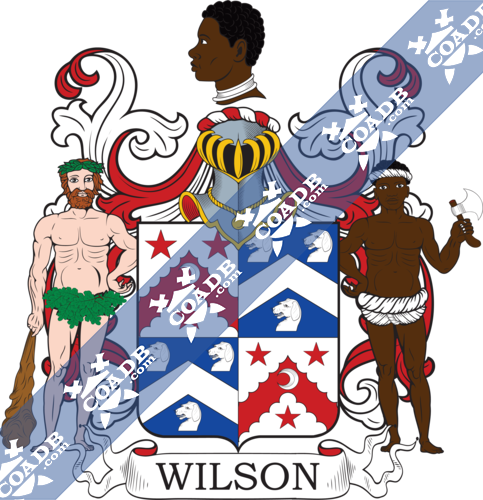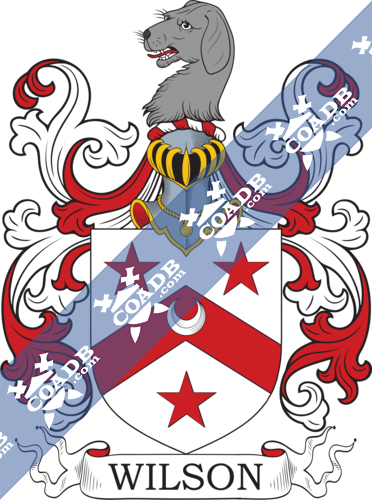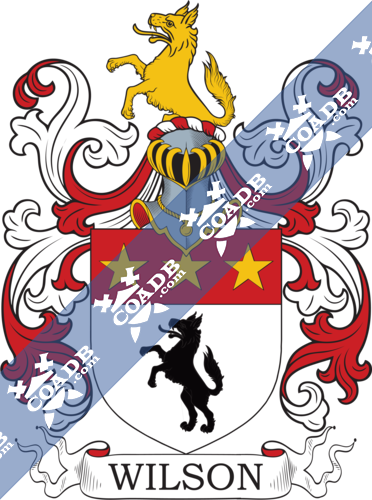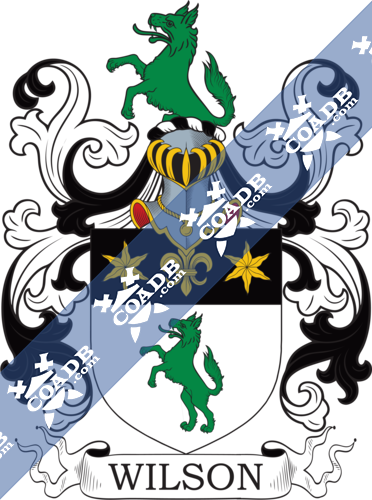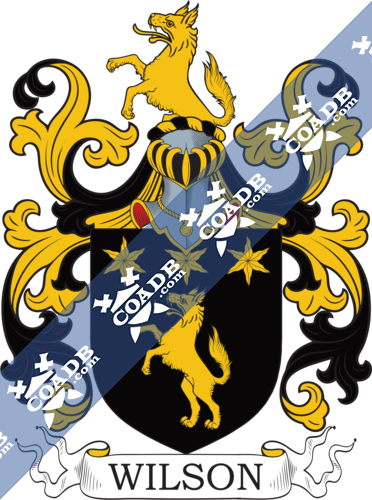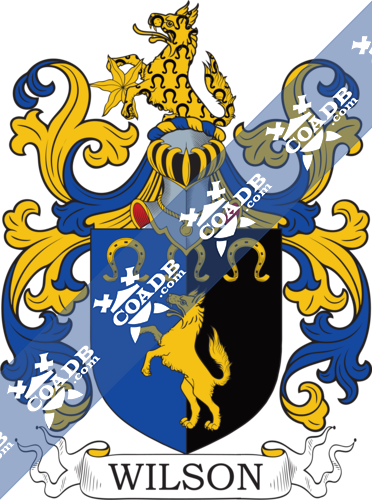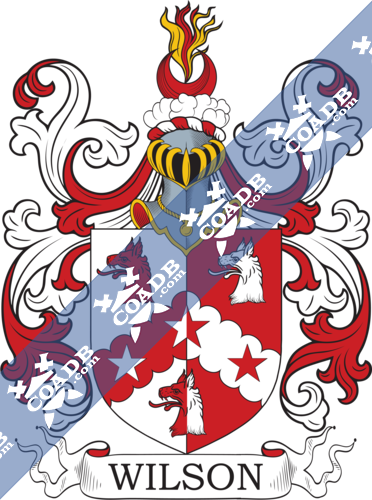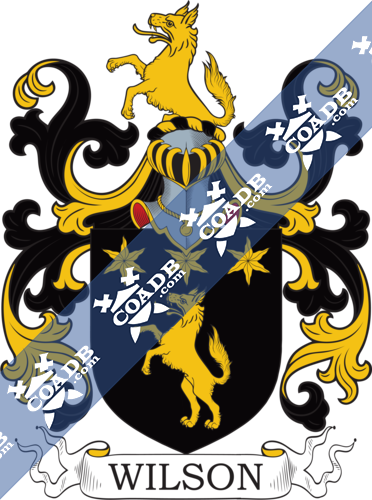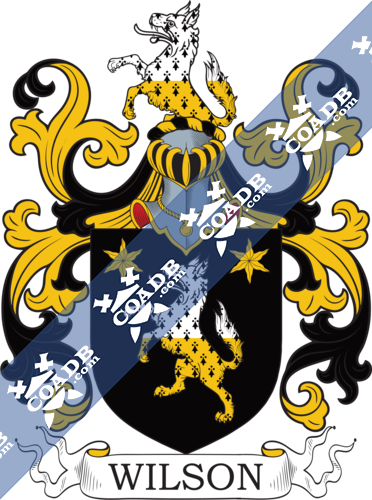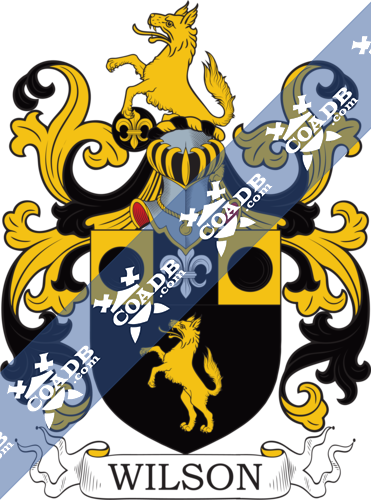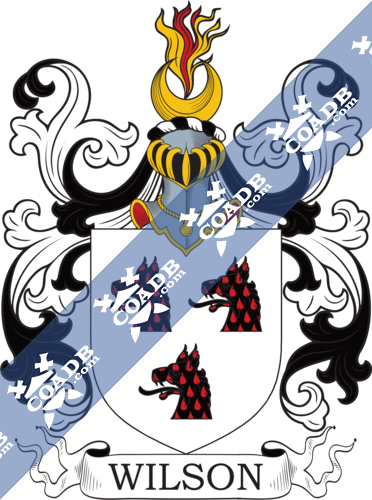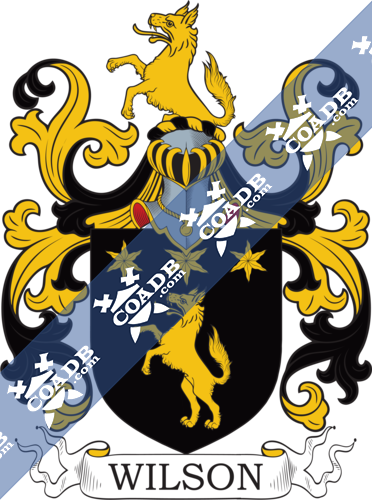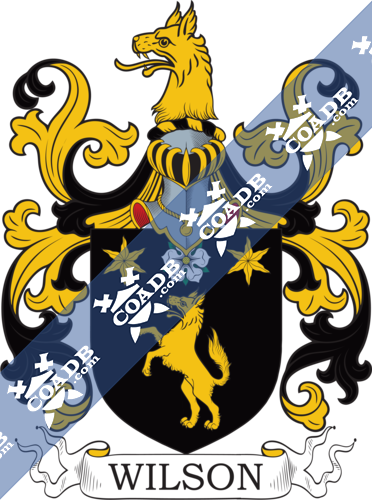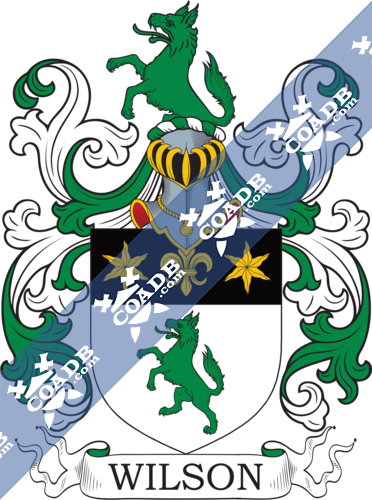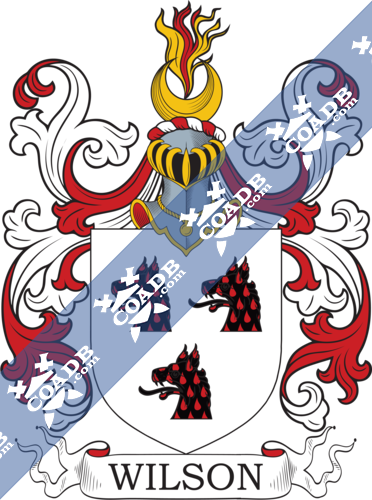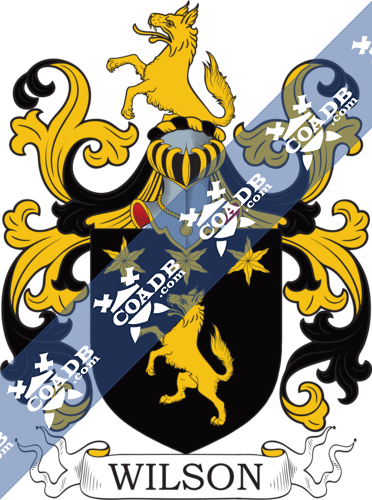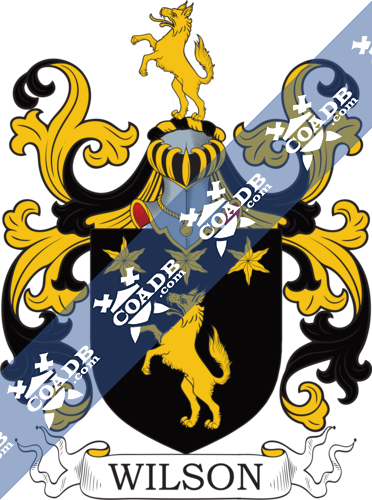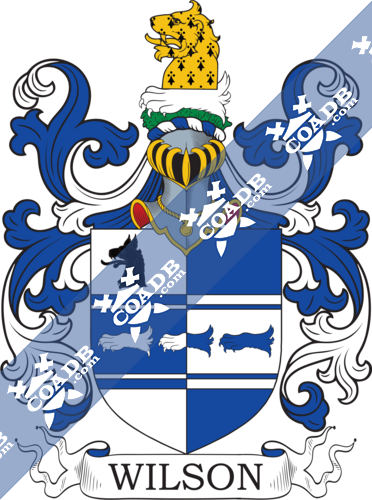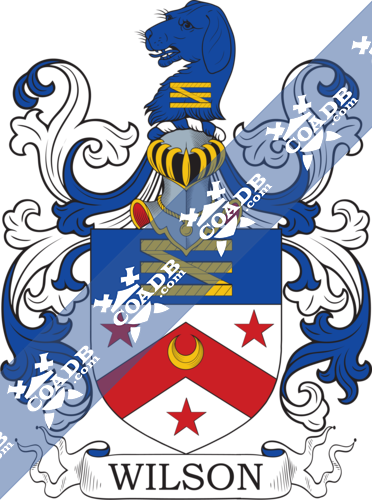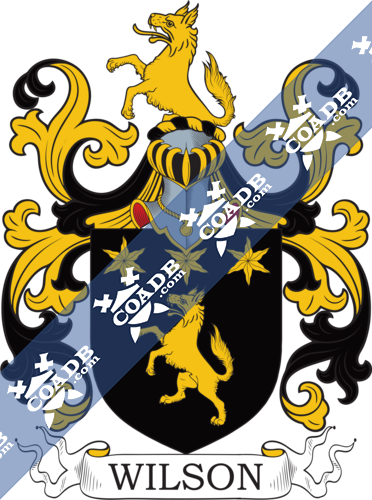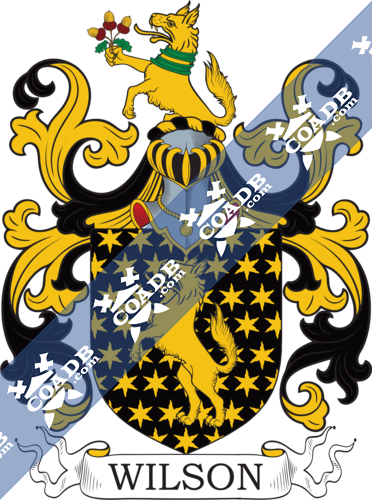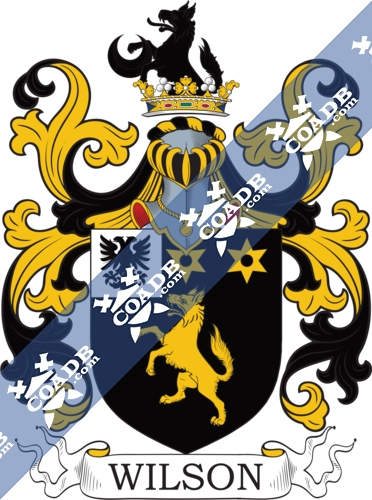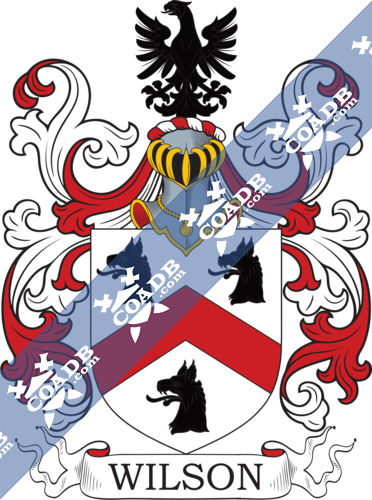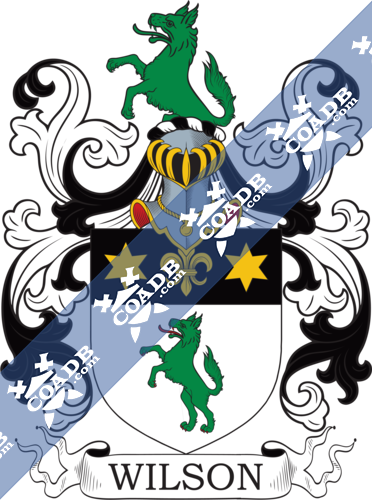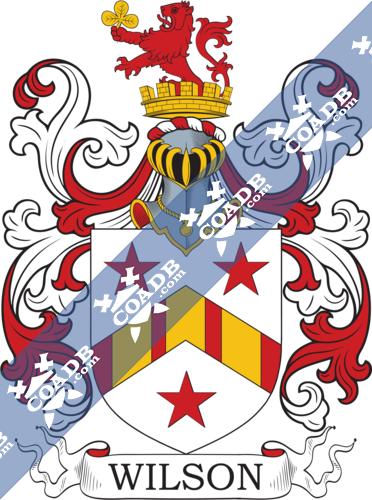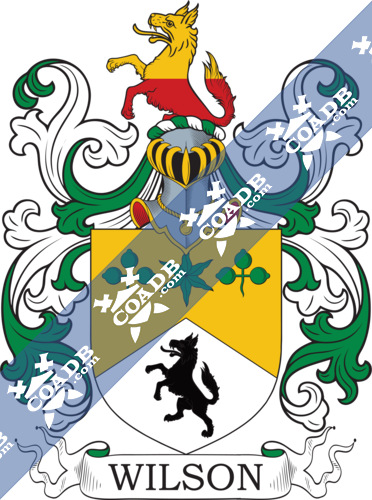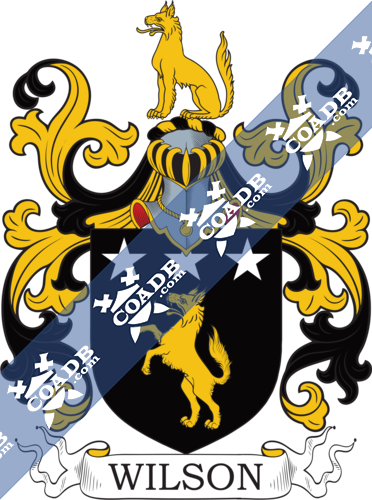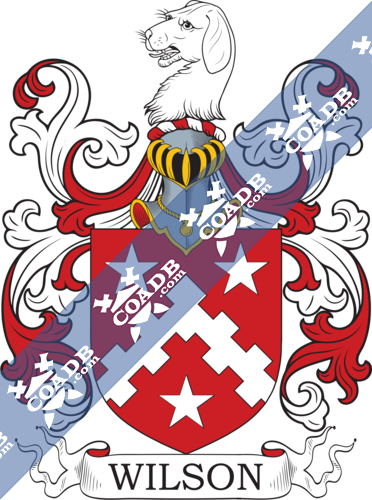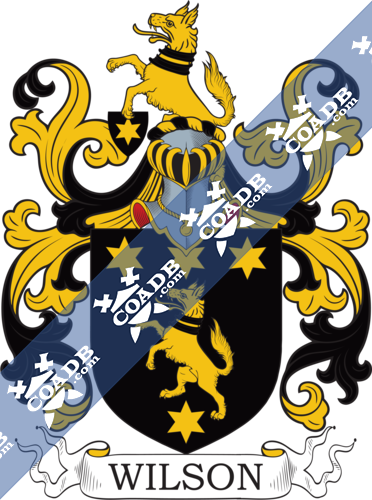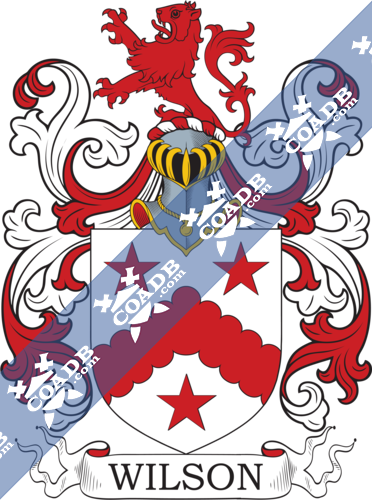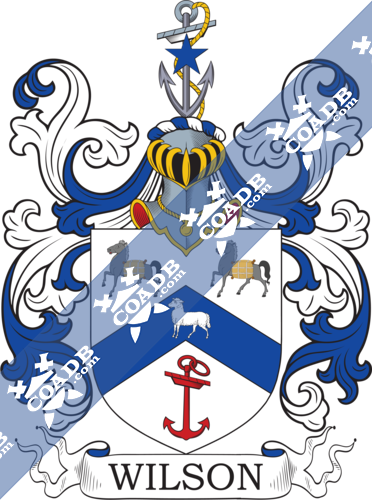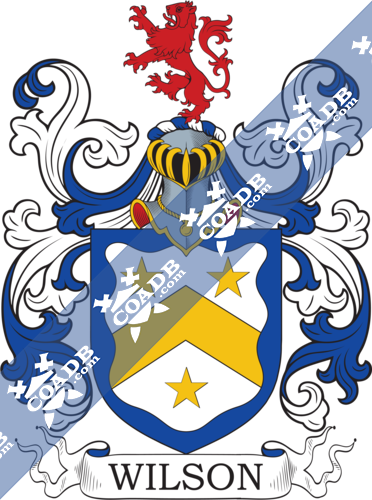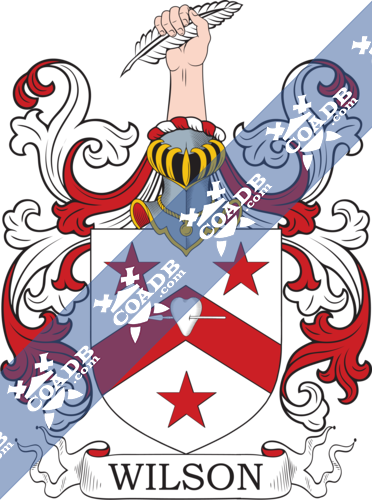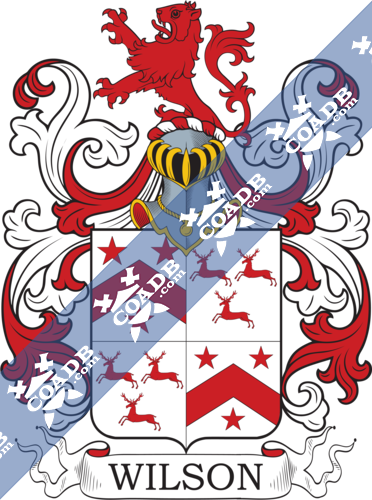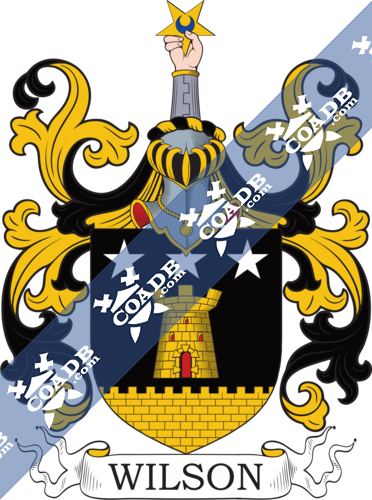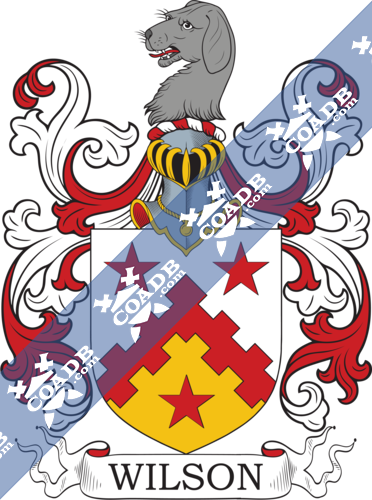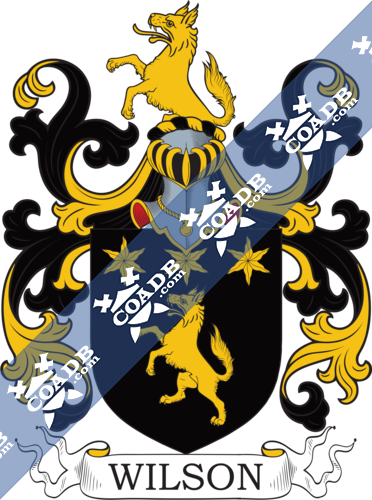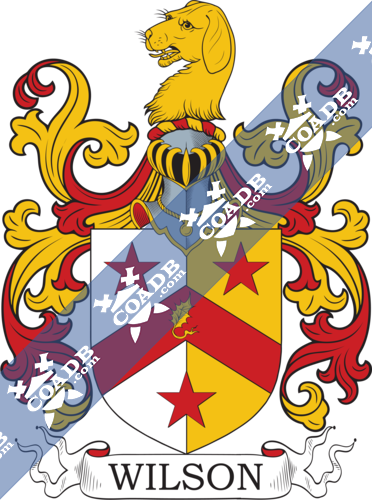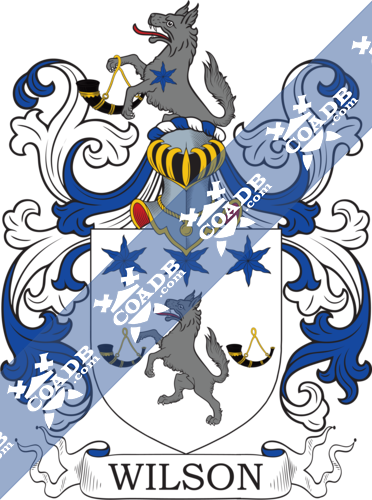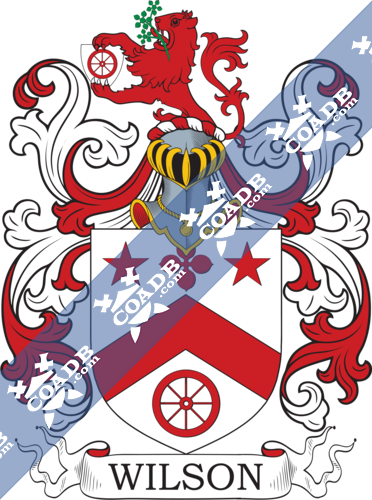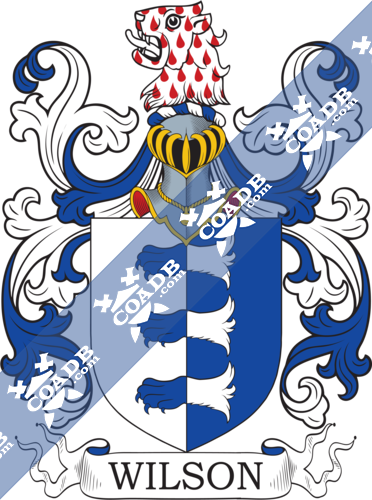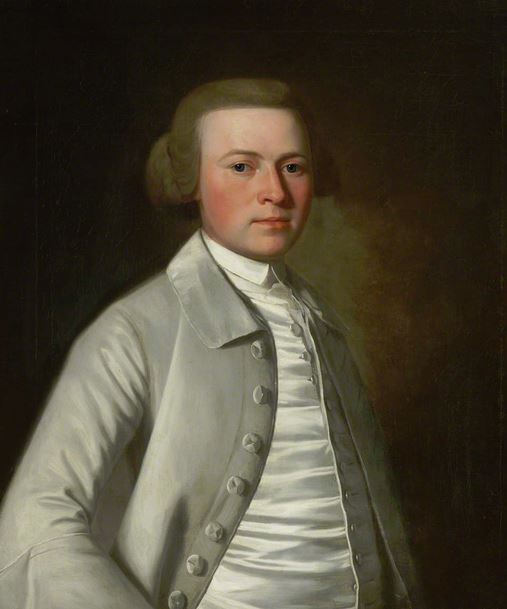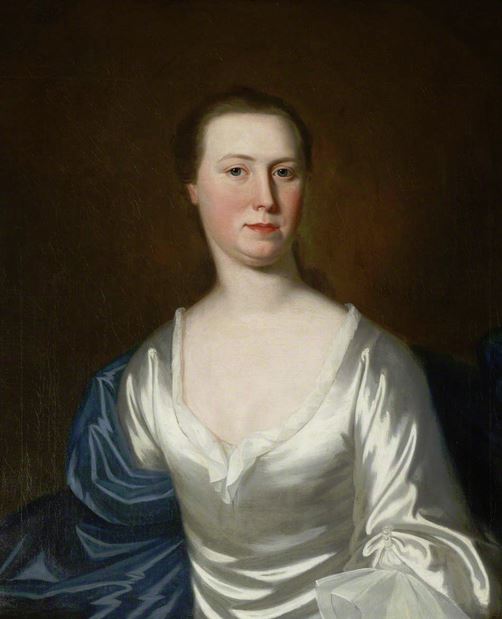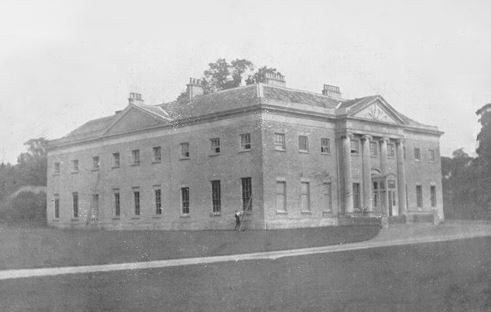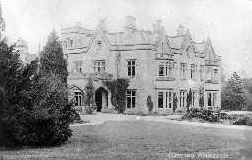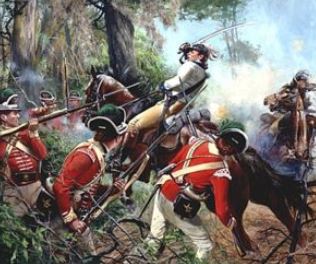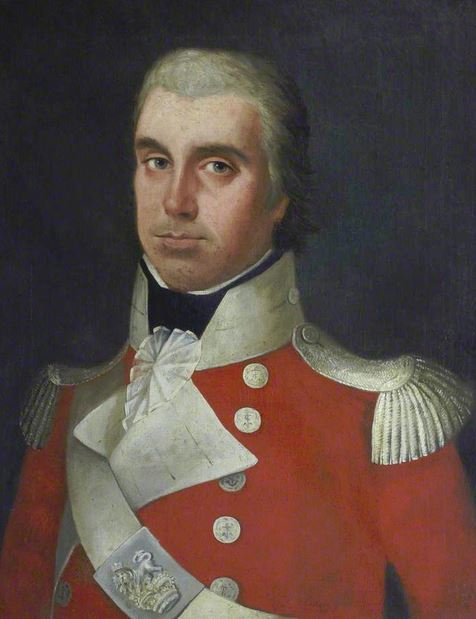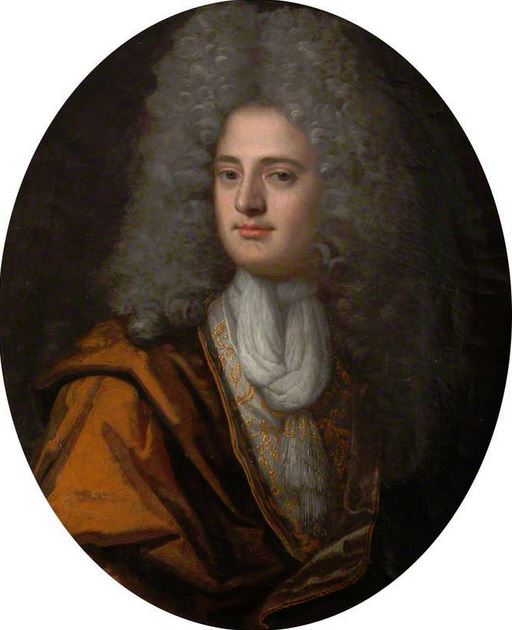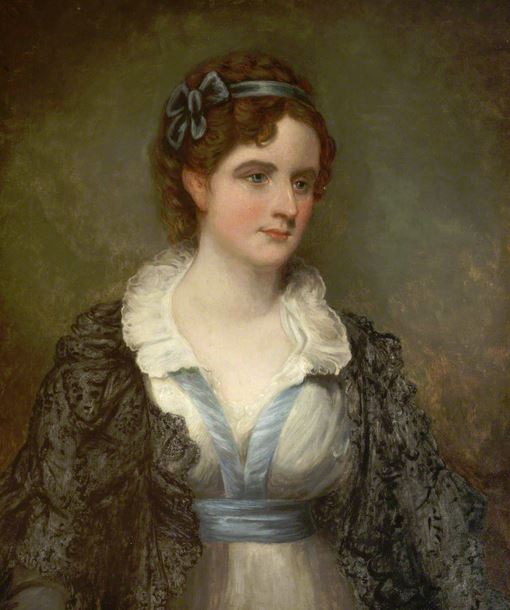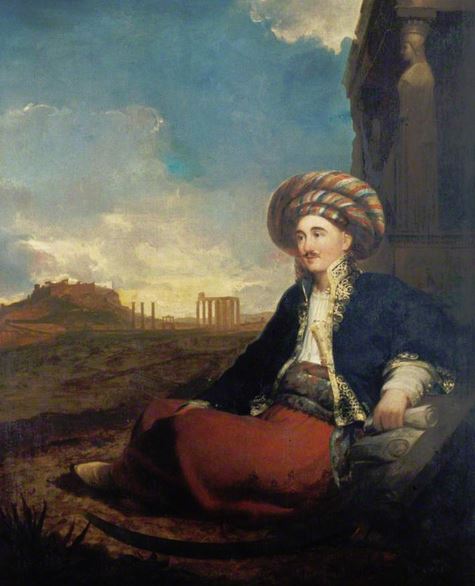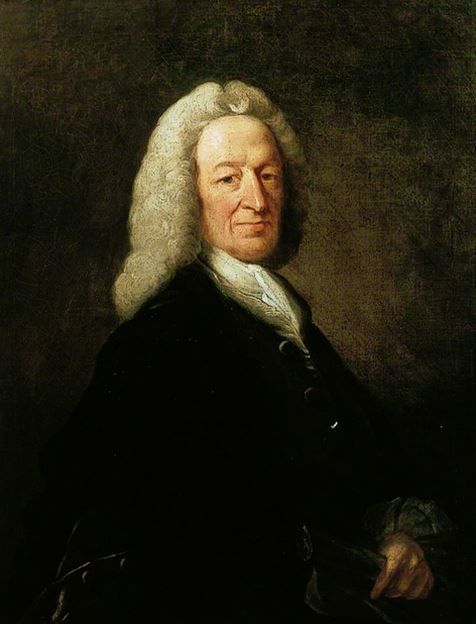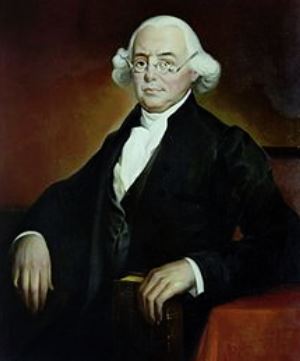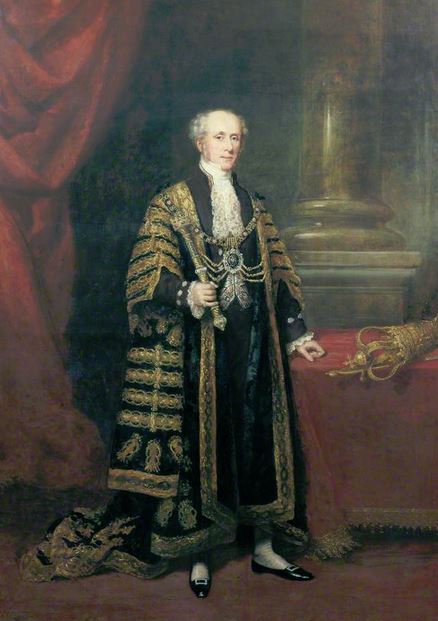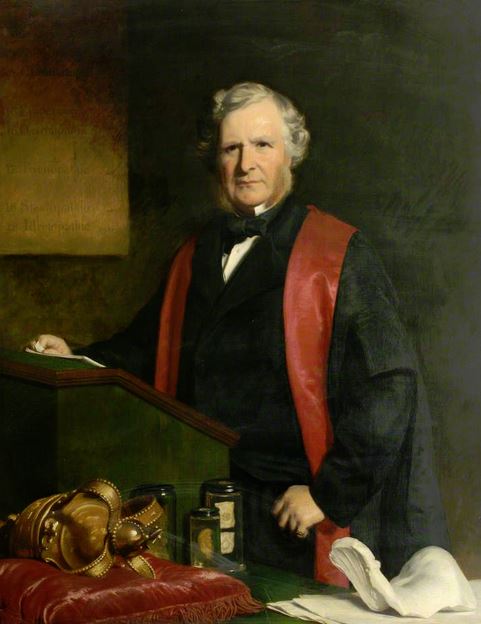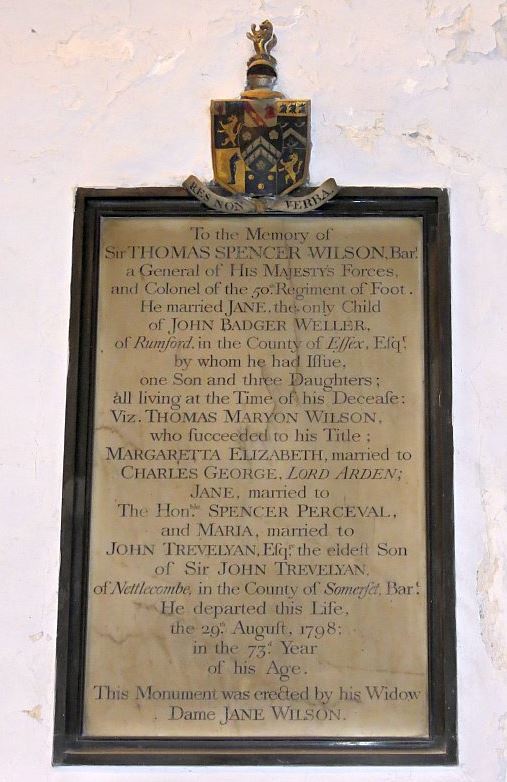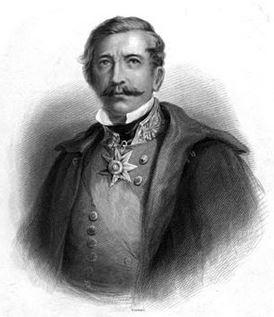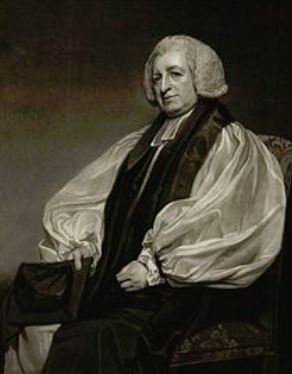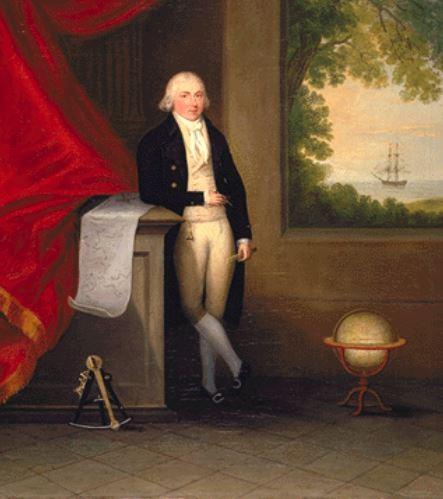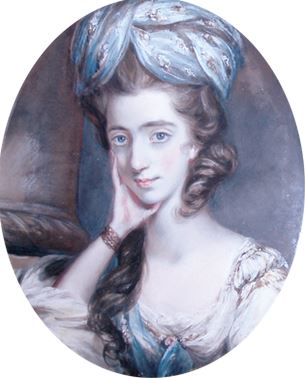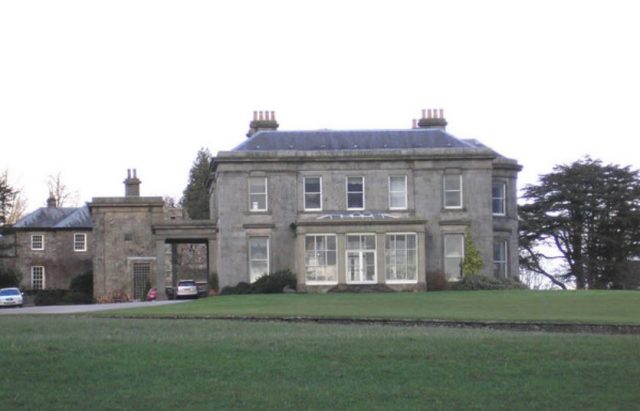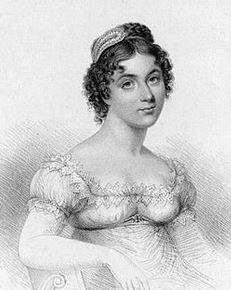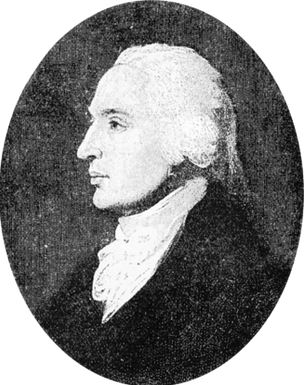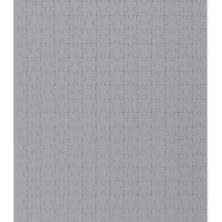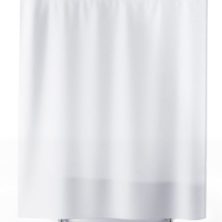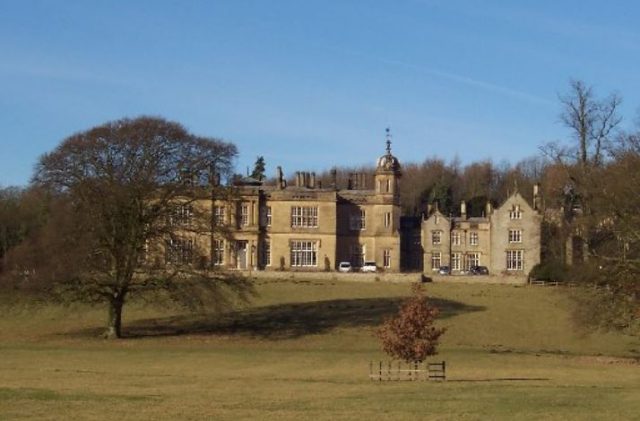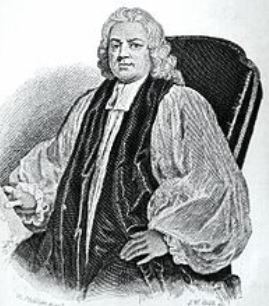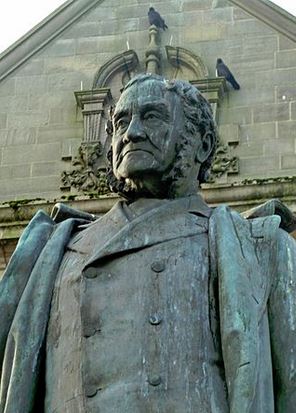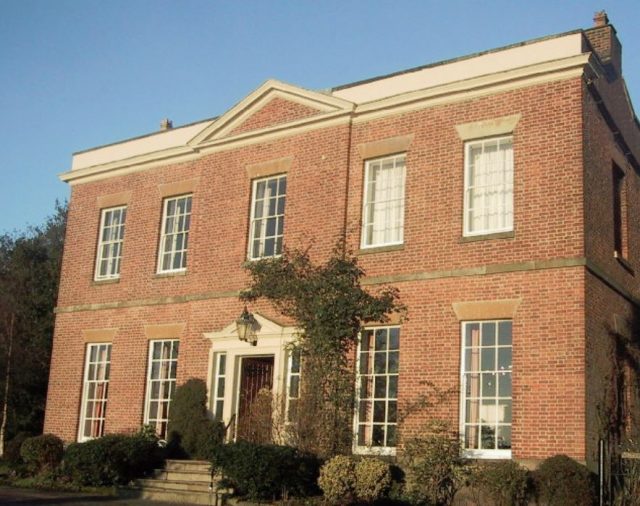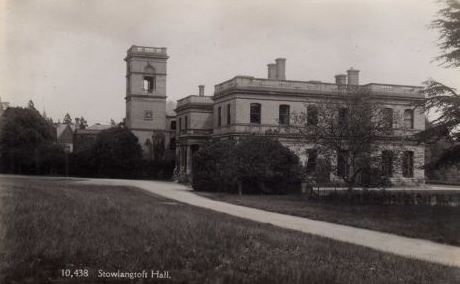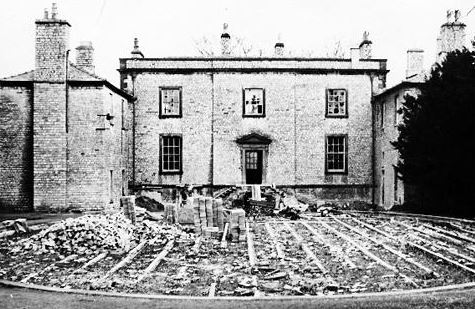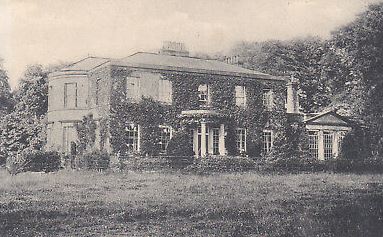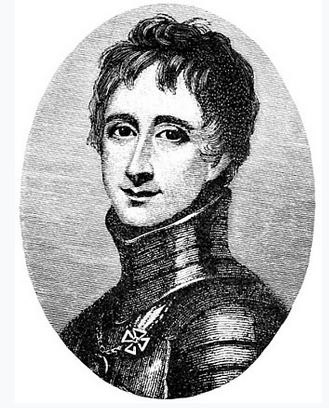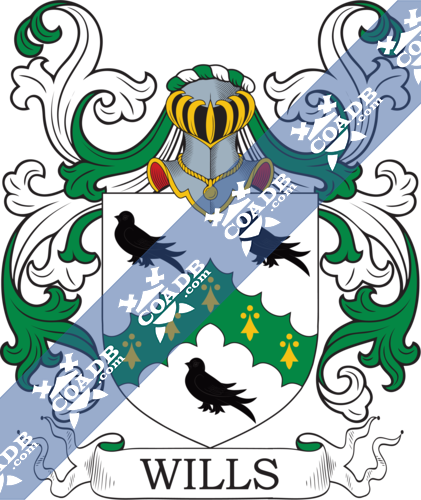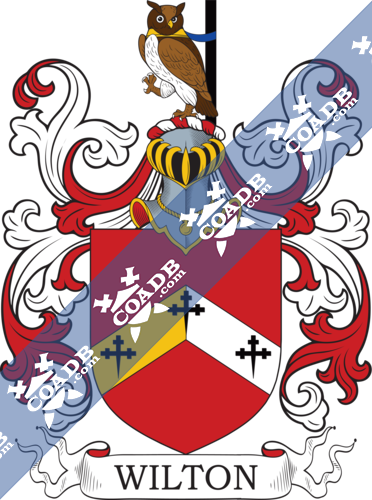Wilson Family Crest, Coat of Arms and Name History
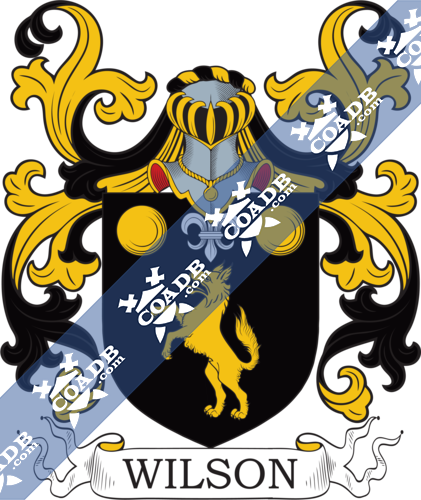
Wilson Coat of Arms Gallery
Don’t know which Coat of Arms is yours?
We can do a genealogical research. Find out the exact history of your family!
Learn MoreSurname Meaning, Origin, and Etymology
The surname Wilson has more than just one origin. Its roots are linked to countries like England, Scotland, and Ireland. Wilson is a surname that is derived from the name William, which is a compound of two words: “will,” which means desire, and “helm,” which means helmet. On the other hand, the surname Wilson means “son of William” or “son of Wil”, “Will-son.”
As mentioned above, the Wilson surname has 3 possible origins. The first one is England, where in the Court Rolls of the manor of Wakefield, Yorkshire in 1324 there was a Robert Wileson listed. Another who also was in Yorkshire was Robert Wilson, who can be seen in documents from the Cistercian Abbey of Kirkstall in 1341. There are historians who claimed that this line of Wilson in Yorkshire descended from Sir William de Waldershelf, who accompanied William the Conqueror during the Norman Conquest in 1066. Sir William took the lands of Yorkshire and had a descendant, John de Hunself and Waldershelf, who had a son named William. In turn, William had a son named John, who take the surname Wilson to honor his father.
Another origin of this surname is Scotland, where there are old records of people with this surname. The last name is linked to the Viking settlers who arrived in Scotland in medieval times. In these regions, the surname Wilson is very old, and it is even linked to people who reached Scotland from Denmark. However, the first one to be found in a record is John Wulson, a merchant who served Sir John of Montgomery in 1405 in the ancient county of Berwickshire.
On the Irish side, it is believed that the surname reached this area thanks to the people who traveled from England and Scotland during the 17th century.
Coat of arms
As we already mentioned, there were several lines of this surname. Each one of these lines gave birth to new family groups who came up with their own particular coat of arms. The common element in all of their coat of arms was the howling wolf. One of the most beautiful crests for the Wilson surname is one from the Irish side of the family, in which the colors green and yellow are predominant. Its most important elements are the yellow or gold color, which express generosity; black, which means constancy and also grief in some occasions; the green or velt color, which can symbolize hope, joy, loyalty, and love. The Chief represents an achievement in battle or authority and dominion, while the Estoile represents the goodness of God. Furthermore, the fleur de list symbolizes purity and light. And the most important of all, the wolf, symbolizes the rewards of persevering in an important field.
Spelling Variations
Wilson is a surname that has traveled long distances during times when not all cultures relied on a written system for their language, so they had to rely on pronunciation. Due to this fact, plus the mix of languages and dialects and also the different origins that it has, this surname has several spelling variations. Some of them are: Willson, Wilsone, Wilsoun, Willsonne, Wulson, Wilsoun, Wolosoun, Wolfson, Wilfson, Wylsone, among others.
Popularity & Geographic Distribution
As so happens with other surnames that have more than just one origin, Wilson is a popular last name thanks to how widely it spread. Actually, Wilson is in the 270th position in the rank of the most common surnames in the world. There are approximately 1,766,181 people in the world with this surname. The country where it is most prevalent is the United States and it has the highest density in Turk and Caicos Islands. The second country with most users is England.
Early Bearers of the Surname
Other old bearers of the surname Wilson include John Wilison from England, who appears in the Subsidy Rolls of Lancashire in 1366. In Scotland, there was Michael Wilsoun, who was Burgess of Irvine in 1418, and John Wilson who was Burgess of Berwick in 1647. Also, Thomas Wolsoun, a resident of Neubotel Abbey in 1563, and Dand Vilsone and Pait Vilsoun, both residents of the abbot of Kelson in 1567. There is also a record from 1662 of William Willsoun, who was a resident of Cunyngham Baidland.
History, Genealogy, and Ancestry
The surname Wilson is among the last names with most genealogical lines. The first one is the line of the Wilsons of Brinkcliffe Tower. The head of this family was Reverend James Allen Wilson who was the Rector of Bolton-by-Bolland. He was born on June 3, 1827, and got married on April 4. 1860 to Catherine Remington, the youngest daughter of Henry Remington, Esquire of Melling and Aynsome. They had 6 children: George Allen Wilson (b. June 21, 1867), Henry Remington Allen Wilson (b. November 21, 1869), James Wilson (b. July 21, 1873), Reginald Wellesley Wilson (b. June 18, 1875), and Lionel Gathorne (b. September 25, 1876).
This branch of the Wilson family took up residence in Broomhead after Adam Wilson received the lands from Thomas, Lord Furnival at Wightwhistle, thanks to his performance during the war. Adam married Agnes Hunshelf, daughter of John Hunshelf, and from that union, he received the lands of West-Thorpe in Hoyland Sweyne. Their son, John Wilson, inherited these lands and later passed them on to his son, William Wilson, who had a son of his own named Christopher Wilson, Esquire of Broomhead and Captain in the Parliamentary army. Christopher got married on October 29, 1623 to Mary Ibboston, daughter of Reverend John Ibboston, and they had 6 children. The second son of this union was Charles Wilson who was a Reverend, Rector of Babworth, and Vicar of Sheffield. Circa 1661, he married Ann Altor, daughter of Reverend John Altor, who was also Rector of Little Thurlow. The eldest son of Charles and Ann was John Wilson, Esquire of Broomhead, born on September 13, 1672. He got married in 1711 to Mar Macro, daughter of Thomas Macro, Esquire of Bury St. Edmund. This union resulted in one son and two daughters; the son was John Wilson, Esquire of Broomhead, who was born on April 28, 1719. Years later, on September 11, 1746 he married Susannah Oates and died on March 3, 1783.
Out of all their children, the most remarkable was their fourth child, William Wilson, Esquire of Sheffield. He was born on March 24, 1754, and in October of 1784 he married Sara Allen, daughter of John Allen, Esquire of Chapeltown. William died on August 30, 1829, leaving a son: William of Fentoville, Sheffield, who was born on September 18, 1786. This William married Frances Woolhouse on May 23, 1812. William and his wife Frances had two sons and one daughter: William, George, and Sarah.
The second son of John Wilson and Susannah of Oates was James Wilson, who was born on July 19, 1789 and later became the Esquire of Brincliffe Tower. He got married on May 12, 1825 to Elizabeth Alderson, daughter of Reverend Jonathan Alderson, M.A. Rector of Harthill. James and Elizabeth had three children: James Allen, William Reginald, and Sophia Maria Alderson. James Wilson died on July 14, 1867.
The Wilsons of Dallam Tower are another line of Wilsons. George Edward Wilson, Esquire of Dallam Tower, was the leader of the family. He was born on November 17, 1814 and got married on March 3, 1843. He had 5 children: George Crowle (b. April 23, 1816), Charles Henry (b. December 28, 1847), Edward Hugh (b. February 3, 1849), Gertrude Sophia, and Harriet Maria. This family was one of the most important of the region. Edward Wilson, Esquire of Haversham Hall, was the son of Thomas Wilson of Kendall and grandson of Thomas Wilson, Esquire of Staveley Hall, Kendall. Edward Wilson died in July of 1707 at the age of 89, and he had a son named after him who was Esquire of Dallam Tower and married Catherin Fleming.
Edward and Catherin had a son, Daniel Wilson, who also became Esquire of Dallam Tower. Daniel married Elizabeth Crowle and then died on May 31, 1754, leaving several children behind, including George Wilson, who went on to become Colonel of the 1st Foot Guards. George was born in 1723 and he later married Anne Sybill; they had a daughter, but she died in infancy. Another of Daniel’s sons was Thomas Wilson, Barrister-at-Law. Daniel’s only daughter, Dorothy Wilson, married William Fleming in 1839; their son became a bishop. Edward Wilson was the eldest of Daniel’s children. He became Esquire of Dallam Tower and married Dorothy Fleming on June 19, 1746, with whom he had children of his own.
The children of Edward and Dorothy were Daniel Wilson and Dorothy Wilson. Dorothy married Richard Watson on December 21, 1773. Then, Daniel Wilson became Esquire of Dallam Tower and married Beatrix Egerton, daughter of Samuel Egerton, Esquire of Tatton Park. Through this line and after several marriages with other families and the death of some members was Sarah Wilson, who got married in 1811 to Colonel George Smith. Through this union, the Colonel took the surname Wilson. They had the following children: George Edward, who became Esquire of Dallam Tower, and Charles Henry, who became a reverend and Rector of Coberley. They also had other children including Frederick John, Georgiana, Sarah Maria, Elizabeth Ann, and Frances Laura. Colonel George died on March 3, 1853, and his wife Sarah died on May 29, 1831.
The third line of Wilsons are the Wilsons of Redgrave Hall. The leader of this family was George Holt Wilson, Esquire of Redgrave Hall, Suffolk. He was born on November 16, 1836 and got married on April 20, 1865 to Luey Caroline, the eldest daughter of William Edward James, Esquire of Barrock Park. They had 6 children: George Rowland Wilson (b. February 26, 1867), Arthur Holt Wilson (b. July 24, 1869), Basil Holt Wilson (b. September 7, 1872), Leonard Holt (b. July 28, 1876), and Villiers Holt (b. April 13, 1878).
The Wilsons of Redgrave are actually related to the Wilsons of Dallam Tower. Thomas Wilson, Esquire of Gray’s Inn was the third son of Daniel Wilson, Esquire of Dallam Tower, and his wife Elizabeth Crowle. Thomas married Lucinda Holt and died in 1808. This couple had two daughters, Lucinda and Isabella, and two sons, George and Daniel. The eldest, George Wilson, became Esquire of Redgrave Hall and also an Admiral. He married Catherine Pollard on August 22, 1831.
George and Catherine had many children. The first was George St. Vincent, who was the heir. Their second son, Thomas Daniel Holt, became a reverend and Rector of Redgrave. Thomas married Barbara Hales on November 26, 1839, and had their children, Charles Holt, Thomas Holt, Algernon George, Edward Hales, and John Henry. The third son of George and Catherine was Charles John, and they later had other children including John Wood, Lucinda Mary, Susan Mary, and Catherine Sarah.
Their first son George St. Vincent, became Esquire of Redgrave Hall and married Mathilda Louisa Surtees on June 5 of 1834. George died in December of 1852 and left two daughters and one son: Matilda Catherine, Anna Maria, and George Holt Vincent, who later became Esquire of Redgrave Hall.
The final line of Wilsons to mention is the Wilsons of Cliffe Hall, whose leader was John Wilson, Esquire of Cliffe Hall at York and Captain of the 94th regiment. He was born in December of 1841 and got married on June 4, 1873 to Angeline Rose, daughter of Rev. Henry O’Brien. Together, they had the following sons: Richard Bassett in 1874, Murrough John in 1875, and Harriet Anne Dorothy in 1876.
The lineage of this family comes from John Wilson, Esquire of Seacrofth and Cliffle Hall, who got married in 1799 to Martha, daughter of Richard Bassett, Esquire of Glentworth. They had two sons: Richard Bassett of Cliffle Hall and John of Seacrofth Hall, who married Anna Maria Isabella, daughter of Roderick Macloud, Esquire of Cadboll, in 1846. John and Anna had a son, Roderick John, who was a Barrister-at-Law.
Richard Bassett Wilson, born in 1806, was the heir of John Wilson and became Esquire of Cliffle Hall. He married Anne Fitzgerald on December 5, 1839. Richard died on March 23, 1867 and left the following children: John Gerald of Cliffle Hall, William Henry, who also took the surname Fitzgerald in 1872; Richard Bassett, born in 1846; Maurice Fitzgerald, who was born in 1858, and Juliana Cecilia, who married Thomas Sowerby in 1865. Juliana and Thomas had their children: Mary Lucia, Augusta June, and Emily Gertrude who married James Fitzgerald Bannatyne, Esquire of Summerville, on December 17, 1878.
Early American and New World Settlers
During the 17th, 18th, and 19th centuries, many people decided to travel from Europe to the New World to look for a different life. The emigration of these people to America, contributed to the expansion of their surnames. Wilson was not the exception; therefore, there are many people that need to be mentioned. For example, in the 17th century some of the Wilsons that reached America were: Clement Wilson and John Wilson, who both arrived in Virginia in 1623. In 1651, Andrew Wilson had the opportunity to reach New England, and another Andrew Wilson got to Boston, Massachusetts as well as Christopher Wilson, a prisoner from Scotland.
During the 18th century, the arrival of Wilsons to America kept on going, and therefore we have Cornelius Wilson, who got to Virginia in 1712, and David Wilson, who also landed in Virginia, but in 1719. Other early settlers in America include Anne Wilson, who got to Maryland in 1734; Alexander Wilson, a man with Scottish and Irish ascendency who arrived in Boston between 1730 and 1736, and Elizabeth Wilson, who got to Augusta County, VA in 1740.
In the 19th century, Samuel Wilson landed in New York; he traveled from Londonderry in 1803. That same year, Joseph Wilson got to Philadelphia from Belfast. Also in 1803, Eleanor Wilson arrived in Pennsylvania. In 1806, James Wilson traveled to New York from Dublin, and the next year, Brown Wilson reached Ohio.
As in other occasions, the US was not the only country to receive immigrants with the Wilson surname since Canada did so too. In 1703, Richard Wilson arrived in Saint John, Newfoundland. Others got to Nova Scotia in 1774, such as Ann Wilson and Barbara Wilson. Also, Mr. Dyann Wilson U.E. reached Prot Roseway, Nova Scotia in 1783; he traveled from New York.
In the 19th century, more Wilsons landed in Canada, such as John Wilson, who got to Saint John, Newfoundland in 1813; he traveled from Yorkshire. Then, in 1815, George Wilson, Isobel Wilson, and James Wilson landed in Quebec aboard the Atlas.
Mottoes
Thanks to how widely it spread across the world, there are many families with the Wilson surname that are not related to each other. Therefore, there also have many different mottoes. Among the most important mottoes, we can find:
- “Expecta cuncta superné” or “expect all things from above.”
- “Facta non verba” or “deeds not worts.”
- “Fortiter et fideliter” or “boldly and faithfully.”
- “Non nobis solum,” which means “not for ourselves alone.”
- “Perserverantia palma,” which means “by perseverance (one gains) the palm.”
- “Pro leqibus et regibus,” which means “for laws and kings.”
- “Res non verba” or “facts not words.”
- “Semper vigilans” or “always watchful.”
- “Venture and gain.”
- “Vincit qui se vincit” or “he conquers who conquers himself.”
- “Virtus ad sidera tollit,” which means “virtue raises to the starts.”
- “Virtus sibi premium,” which is translated as “virtue is its own reward.”
Mottoes were used by families to express many different things, such as how they live, their code of honor, how they see the word, or the things that are important to them, like religion and honor. They also helped families differentiate themselves from the rest, as each one had their own unique motto.
Grantees
We were unable to locate any documented grantees for the Wilson family.
Notables
There have been many bearers of the Wilson surname with outstanding careers in their respective fields. Among the most important we have: A.D. Wilson (1844-1920) a cartographer from the US, Aaron Wilson, a Canadian lacrosse player born on 1980, Alastair Wilson (b. 1983) a British Field hockey player, and Alan Wilson (b. 1973), a politician who is the current Attorney General of South Carolina. Moreover, there is Amanda Wilson, a British singer born in 1980, and Amy Wilson, an American artist born in 1973. In sports, there is B.A. Wilson, a Nascar driver from the US. Furthermore, there is Bee Wilson, the British food writer, and historian, and the first female Puisne Justice of the Supreme Court of Canada, Bertha Wilson (1923-2007). Other notables Wilsons, include the singer-songwriter and producer from Australia, Boyd Wilson, American boxer Darroll Wilson, actress and comedian Debra Wilson (b. 1962), and US journalist Earl Wilson (1907-1987). Royston Warner Wilson (1900-1965), was an English script and cartoonist, while John Dover Wilson (1881-1969) was a Shakespearean scholar, and Sir Erasmus Wilson (1809-1887) was an English surgeon and antiquarian.
Blazons & Genealogy Notes
2) (Christopher Wilson, Bishop of Bristol, 1783-92). Sa. a wolf salient or, in chief three mullets of six points ar.
3) (Thomas Wilson, Bishop of Sodor and Man, 16971755). Sa. a wolf salient or, in chief three estoiles of the last.
4) (Eastbourne, co. Sussex, bart.). Sa. a wolf ramp, or, in chief three estoiles of the last. Crest—A demi wolf ramp. or, motto over, Pro legibus ac regibus. Motto—Res non verba.
5) (Delhi, bart.). Quarterly, 1st and 6th, sa. a wolf salient or, in chief a fleur-de-lis ar. betw. two bezants, for Wilson; 2nd, ar. a bend sa. a border engr. of the last, for Knyvett; 3rd, ar. a cross engr. betw. four water bougets sa. a label of three points az. charged with three lions ramp., for Bourchier; 4th, France and England, quarterly, a border ar., for Plantagenet; 5th, quarterly, or and vert, for Berners.
6) (Eshton Hall, co. York, bart.). Sa. a wolf ramp. or, gorged with a collar gcincl of the field betw. four mullets of six points, three in chief and one in base of the second. Crest—A demi wolf or, gorged with a collar gemel sa. resting the sinister paw on an escuteheon also sa. charged with a mullet, as in the arms. Mottoes—Res non verba; and, Loyal en tout.
7) (Ives Place, Maidenhead, co. Berks). Sa. a wolf ramp. or, in chief three estoiles of the last. Crest—A demi wolf ramp. or, motto over, Pro legibus ac regibus. Motto—Res non verba.
8) (Penrith, co. Cumberland, and Welborne, co. Lincoln; granted 24 March, 1586). Per pale ar. and az. three lions’ gambs erased fessways in pale counterchanged. Crest—A lion’s head ar. guttee de sang.
9) (Field House, Brancepeth, and Lumley Castle, co. Durham; descended from John Wilson, Private Secretary to Charles Nevill, sixth and last Earl of Westmorland). Sa. a wolf salient or, in chief three estoiles of the last.
10) (Cliffe Hall, co. Durham). Per pale ar and az. on a fess cotised three lions’ gambs erased fessways all counterchanged, in the dexter chief quarter a wolfs head erased sa. Crest—On a mount vert a lion’s gamb erased fessways ar. thereon a lion’s head couped erminois.
11) (Bocking, co. Essex). Gu. on a fess betw. three cushions ar. tasselled or, a fleur-de-lis of the first.
12) (co. Essex). Gu. a fess betw. three lozenges ar. each charged with a fleur-de-lis of the field.
13) (Frenchay, co. Gloucester). Gu. guttee de larmes two swords in saltire ar. pommels and hilts or, over all a lion ramp. of the second.
14) (co. Hertford). Sa. a wolf salient or, in chief three estoiles ar. a crescent for diff. Crest—A demi wolf or.
15) (West Wickham, co. Kent; confirmed at Edinburgh, 20 July, 1762). Ar. on a chev betw. three mullets gu. a crescent of the first. Crest—A talbot’s head erased ppr. Motto—Semper vigilans.
16) (Rivington Hall, co. Lancaster; originally of South Tunley, in the same co.; Thomas Wilson, Esq., of South Tunley, temp. Charles I., was grandfather of Lawrence Wilson, Esq., whose only son, Joseph Wilson, Esq., of Rivington Hall, dying s. p. 1765, was s. by his sisters and co-heirs, Sarah, m. Rev. John Milne, and d. s. p. ; and Elizabeth, m. James Hurst, Esq., of Hurst, co. Lancaster, by whom she had an only dau. and heir, Sarah, m. 1764, Joseph Lowe, Esq., of Highfleld, co. Nottingham). Ar. a wolf salient sa. on a chief gu. three mullets or. Crest—A demi wolf or.
17) (High Wray. co. Lancaster). Ar. a wolf salient vert, on a chief sa. a fleur-de-lis betw. two estoiles or. Crest —A demi wolf ramp. vert.
18) (co. Leicester). Sa. a wolf salient or, in chief a fleur-de-lis of the last betw. two bezants.
19) (Stralby, co. Lincoln). Sa. a wolf salient or, in chief three estoiles of the last. Crest—A demi wolf salient or.
20) (co. Middlesex; Thomas Wilson, Esq., of Elsbrock, in South Holland, in the Netherlands, and of Gloucester Square, Hyde Park). Per pale az. and sa. a wolf salient, and in chief three horseshoes or. Crest—A demi wolf or, semee of horseshoes sa. holding betw. the paws an estoile gold. Motto—Pro legibus ac regibus.
21) (Stratford-le-Bow, co. Middlesex). Per pale ar. And gu. on a chev. invecked betw. three wolves’ heads erased as many mullets all counterchanged. Crest—On a cloud ppr. a crescent gu. issuing fire ppr.
22) (Forest Hall, co. Northumberland). Sa. a wolf salient or, in chief three estoiles of the last. Crest—A demi wolf salient or.
23) (Flatt, co. Northumberland; confirmed 3 Nov. 1773). Sa. a wolf ramp, per fess erm. and erminois, in chief two estoiles or. Crest—A demi wolf ramp. per fess erm. and erminois.
24) (Stowlangtoft Hall, co Suffolk; Henry Wilson, Esq., of Stowlangtoft Hall, J. P. and D.L., formerly M.P. for West Suffolk, only son and heir of Joseph Wilson, Esq., of Highbury Hill, co. Middlesex, Little Massingham, co. Norfolk, and Stowlangtoft, co. Suffolk). Sa. a wolf salient or, on a cliiff of the last a pale of the first, charged with a fleur-de-lis ar. betw. two pellets. Crest—A demi wolf or, the sinister paw resting on a pellet, charged with a fleur-de-Iis gold. Motto—Wil sone wil.
25) (Redgrave Hall, co. Suffolk). Ar. three wolves’ heads couped sa. guttee de sang. Crest—A crescent or, issuing flames of fire ppr.
26) (Shesfield, co. Sussex). Sa. a wolf salient or, in chief three estollci of the last. Crest—A demi wolf salient or.
27) (Knowle Hall, co. Warwick). Sa. a wolf salient or, in chief a rose ar. seeded and barbed ppr. betw. two estoiles or. Crest—A wolf’s head or. Motto—Fortiter et fideliter.
28) (Abbot Hall, co. Westmorland). Ar. a wolf ramp. vert, on a chief sa. a fleur-de-lis betw. two estoiles or. Creit —A demi wolf ramp. Vert.
29) (Carus-Wilson, Casterton Hall, co. Westmorland), Quarterly, 1st and 4th, ar. three wolves’ heads couped sa. vulned in the neck ppr., for Wilson; 2nd and 3rd, az. on a chev. engr. or, betw. nine quatrefoils ar. three mullets gu., for Carus, of Kirby-Lonsdale. Crests—1st, Wilson: A crescent or, issuing flames of fire ppr.; 2nd, Cakus: A hawk rising sa. beaked, belled, and collared or, from the collar an escutcheon pendent ar. charped with a wolf’s head also sa. vulned ppr. Motto—Non nobis solum.
30) (Dallam Tower, co. Westmorland). Ar. three wolves’ heads couped sa. guttee de sang. Crest—A crescent or, issuing flames of fire ppr.
31) (co. Worcester; arms from the monumental tablet of Thomas Wilson, D.D., Dean of Worcester 1571, who d. 1639, aged 93, and borne by his descendant. Rev. George Wilson, Rector of St. Clement’s, co. Worcester). Sa. a wolf salient or, in chief three mullets of the last. Crest—A demi wolf salient or.
32) (Banner Cross, Eccleshall, co. York). Az. two chevronels ar. betw. as many mullets in chief of the last and a wolf salient in base or. Crest—Issuant from flames ppr. a demi lion az. gorged with a collar gemel, and holding in the dexter paw a mullet both ar.
33) (Brinckliffe Tower, co. York). Sa. a wolf ramp. in chief three estoiles or. Crest—A demi wolf ramp. or. Motto—Vincit qui se vincit.
34) (Elton, co. York). Sa. a wolf salient or, in chief three estoiles of the last. Crest—A wolf salient or.
35) (Fleymore, co. York; descended from Wilson, of Shepwalsh, co. Lincoln; Fun. Ent. Ulster’s Oflice, 1568. Susanna, wife of Rowland Wilson, Clerk of the Crown in Ireland, son of Thomas Wilson, Esq., of Fleymore). Sa. a wolf ramp. or, armed and langued gu. in chief three estoiles of the second.
36) (Wilson-Todd) (Tranby Park and Halnaby Hall, co. York; exemplified to William Henry Wilson, Esq., late Capt. 39th Regiment, third son of Joshua Wilson, Esq., of Roseville, co. Wexford, Col. in the Army, upon his assuming by royal licence, 14 Aug. 1855, the additional surname of Todd, in right of his wife, Jane Marian Rutherford, only child and heiress of John Todd, Esq., of Halnaby Hall and Tranby Park, J. P.). Quarterly, 1st and 4th, ar. a mascle pierced betw. three foxes’ heads couped gu. on a border vert four martlets of the first, for Todd; 2nd and 3rd, ar. on a chev. betw. three mullets gu. as many palets or, for Wilson. Crests—1st, Todd: On a trunk of an oak tree fessways a fox sejant ppr. collared or; 2nd, Wilson: Out of a mural coronet or, a demi lion ramp. gu. holding in the dexter paw a trefoil gold, motto over, Semper vigilans. Motto—Oportet vivere.
37) (Seacroft, co. York). Per pale ar. and az. on a fess cotised three lions’ gambs erased fessways all counterchanged, in the dexter chief quarter a wolf’s head erased sa. Crest—On a mount vert a lion’s gamb erased fessways ar. thereon a lion’s head couped erminois.
38) (Sneaton Castle, co. York). Ar. on a chev. betw. three mullets gu. a crescentor, on a chief az. as many ingots of gold in fess crossed by another in bend ppr. Crest—A talbot’s head erased az. charged on the neck with three ingots of gold in fess crossed by another in bend ppr. as in the arms.
39) (Fountayne-Wilson, Melton, co. York; Richard Wilson, Esq., of Rudding Hall, co. York, m. Elizabeth, dau. of Very Rev. John Fountatne, D.D., Dean of York, and was father of Richard Fountayne-Wilson, Esq., of Melton). Quarterly, 1st and 4th, sa. a wolf salient or, in chief two estoiles ar. on a canton or, a cross pattee gu., for Wilson; 2nd and 3rd, or, a fess gu. betw. three elephants heads sa., for Fountayne. Crests—1st: A demi wolf sa. holding a shield; 2nd: On a mount an elephant all ppr.
40) (James Wilson, Esq., of Greek Street, Soho). Sa. semee of estoiles a wolf salient or. Crest—A demi wolf or, gorged with a collar gemel vert, in the dexter forepaw a branch of oak fructed ppr.
41) (Lieut.-General Sir Robert Wilson). Sa. a wolf ramp, or, in chief three stars of six points of the last, pierced of the field, on a canton ar. an eagle displ. with two heads sa. Crest—Out of a marquess’s coronet or, jewelled ppr a demi wolf bolding betw. the paws a crescent sa.
42) Per pale az. and ar. three lions’ gambs barways erased and counterchanged. Crest—A lion’s head erased ar. Crest: A lion’s head ar. guttee de sang.
43) Ar. a chev. betw. two mullets in chief gu. and a crescent in base az.
44) Or, two bars az. on a canton of the last a lion pass. of the first.
45) Per pale sa. and or, three lions’ gambs in pale lying barways erased counterchanged.
46) Ar. a chev. gu. betw. three wolves’ heads erased sa. Crest—An eagle displ. sa.
47) Sa. on a cross engr. betw. four cherubim or, a human heart of the first wounded on the left side ppr. And crowned with a crown of thorns vert.
48) (Robert Wilson, Dean of Ferns, 1629-43, m. Susan, dau. of Thomas Ram, Bishop of Ferns; impalement Fun. Ent. Ulster’s Office, 1677, Ralph Wallis, whose second wife was Jane Wilson, dau. of the Dean). Sa. a wolf ramp. or, in chief three estoiles of the last.
49) (quartered by Carney; Fun. Ent. Ulster’s Office, 1658, Ellen, wife of Edward Carney). Per pale or and sa. three lions’ gambs erased in pale barways counterchanged, armed gu.
50) (Wilson’s Court, co. Donegal, bart., extinct 1636; Fun. Ent. Ulster’s Office, Sir John Wilson, created a bart. 1629, d. s. p. m.). Sa. a wolf ramp. ar. armed and langued gu. betw. three estoiles or, a crescent for diff.
51) (co. Donegal; Reg. Ulster’s Office). Sa. a wolf ramp. ar. charged on the shoulder with a crescent of the first betw. three estoiles or.
52) (Reg. Ulster’s Office). Ar. a wolf salient vert, armed and langued gu. on a chief sa. a fleur-de-lis betw. two stars of six points or. Crest—A demi wolf salient vert. Motto—Aviumque volatus.
53) (Scarr, co. Wexford; descended from Nicholas Wilson, who got a grant of that place 8 Feb. 22 Charles II.; represented by Wilson-Palliser). (Sledagh, co. Wexford; descended from Benjamin Wilson, who d. 1767, second son of Christian Wilson, Esq., of Scarr). Roseville, co. Wexford; confirmed to William Henry Wilson, Esq., formerly Capt. 39th Foot, son of Joshua Wilson, Esq., of Roseville, who was second son of Christian Wilson, Esq., of Sledagh, same co.). Ar. on a chev. betw. three mullets gu. as many palets or. Crest—Out of a mural crown or, a demi lion ramp. gu. holding in the dexter paw a trefoil gold. Motto—Semper vigilans.
54) (Dublin; granted, 1814, to Rev. James Wilson, Trin. Coll. Dublin, son of James Wilson, of that city, merchant). Per chev. or and ar. in chief an cstoile betw. two trefoils slipped vert, and in base a wolf ramp. sa. Crest—A demi wolf per fess or and gu. Motto —Semper vigilans.
55) (Wilson-Fitzgerald). (exemplified to William Henry Wilson, Esq., of Adelphi, co. Clare, upon his assuming, by royal licence, 1872, the additional surname of Fitzgerald). Quarterly, 1st and 4th, erm. on a saltire gu. a boar’s head couped or, for Fitzgerald; 2nd and 3rd, per fess ar. and az. on a fess cotised three lions’ gambs fesswise all counterchanged, for Wilson. Crests—1st, Fitzgerald: A boar pass. gu. bristled and armed or, charged with a saltire of the last; 2nd, Wilson: On a mount vert in front of a lion’s head erminois a lion’s gamb erased ar. Motto—Shannet a boo.
56) (Fraserburgh, Scotland, 1672). Ar. a chev. betw. two mullets in chief and a crescent in base gu. Motto—Venture and gain.
57) (Fingach, Scotland). Sa. a wolf saliant or, in chief three stars ar. Crest—A wolf sejant or. Motto—Expecta cuncta supeme.
58) (Queensferry, Scotland, 1672). Gu. a chev. Counterembattled betw. three mullets ar. Crest—A talbot’s head erased ar. Motto, as the last.
59) (Croglin, Scotland). Ar. a chev. betw. three mullets gu.; another,
60) (Croglin, Scotland). Ar. a chev. betw. two mullets in chief and a crescent in base az.
61) (Edinburgh, 1674). Ar. on a chev. betw. three mullets gu. a talbot’s head erased of the first. Motto—Semper vigilans.
62) (Plewlands, co. Edinburgh, 1704). Ar. a chev. invecked betw. three mullets gu. Crest—A demi lion ramp. issuant gu. Motto—Semper vigilans.
63) (Kelton, co. Kirkcudbright, 1740). Ar. on a chev. az. betw. two horses with packs corded ppr. in chief and an anchor in base gu. a sheep without horns of the first. Crest—An anchor twisted with a cable surmounted of a star ppr. Motto—Pro Deo et libertate.
64) (Robert Wilson, Lieutenant in Navy, 1760). Ar. a chev. betw. three stars or, a border wavy az. Crest—A lion ramp. gu. Motto—Semper vigilans.
65) (Glenderston, co. Renfrew, 1773). Quarterly, 1st and 4th, ar. on a chev. engr. betw. three stars gu. an increscent of the first; 2nd and 3rd, az. a chev. betw. three talbots’ heads couped ar., for Philip. Crest—A negro’s head ppr. collared ar. Supporters—Dexter, a savage wreathed about the middle with oak, resting on a club ppr.; sinister a negro ppr. wreathed head and middle ar. holding a hatchet erected also ppr. Mottoes—Over the crest: I will, who will not; below the shield: Non dormit qui custodit.
66) (Soonhope and Edinburgh, 1771). Ar. on a chev. betw. three stars gu. a heart pierced w ith a spear of the field. Crest—A dexter hand holding a pen ppr. Motto: Vinute et labore.
67) (Rae-Wilson. Scotland, 1807). Quarterly, 1st and 4th, ar. a chev. betw. three mullets gu., for Wilson; 2nd and 3rd. ar. three stags courant gu., for Rae. Crest: A demi lion ramp. gu. Motto—Semper vigilans.
68) (Banknock, co. Stirling, 1863). Sa. a tower or, masoned of the field, windows and ports gu. betw. three mullets ar. in chief and an embattled wall of the second also masoned of the field In base. Crest—A cubit arm in armour ppr. purfled or, holding in the hand also ppr. a mullet reversed of the second, thereon a crescent az. Motto: Expecta cuncta supeme.
69) (Bishop of Glasgow and Galloway, 1808). Per chev. ar. and or, a chev. counter-embattled betw. three mullets gu. Crest—A talbot’s head erased ppr. Motto—Semper vigilans.
70) (Glasgow, 1871). Per pale ar. and or, on a chev. betw. three mullets gu. a holly leaf of the second. Crest: A talbot’s head erased or. Motto—Semper vigilans.
71) (Western Bank, Sheffield, co. York). Ar. a wolf ramp. ppr. betw. two buglehorns in fesse sa. garnished and stringed or, in chief three estoiles az. Crest—A demi wolf ppr. charged on the shoulder with an estoile az. betw. the paws a buglehorn as in the arms. Motto—Vincit qui se vincit.
72) (Cumberland Terrace, Regent’s Park, co. Middlesex; Greenwich, co. Kent; and of Molesworth House, Brighton, co. Sussex). Ar. a chev. betw. a quatrefoil betw. two mullets in chief and a cart wheel in base, all gu. Crest—A demi lion gu. betw. the paws an escocheon ar. charged with a cart wheel, as in the arms, and holding in the mouth three cinquefoils slipped vert.

